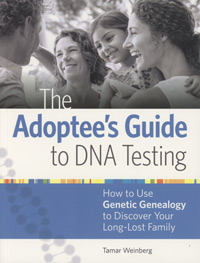| Details: |
|
The Adoptees' Guide to DNA Testing: How to Use Genetic Genealogy to Discover Your Long-Lost Family; by Tamar Weinberg; 239 pp; 2018; Soft Cover; ISBN: 978-1-4403-5337-6; Item #: IG03
Thanks to DNA testing, it’s never been easier for adoptees, foundlings, and others of unknown parentage to find their birth families. But how can DNA tests help you connect to family, and what do your results mean? Enter this book: a comprehensive guide to adoption genealogy that will give you the resources you need to find your long-lost family with DNA. This volume will cover all the basics of genetic testing, plus how your DNA results from services like AncestryDNA, 23andMeFamily Tree DNA, and MyHeritage DNA can help you build out your family tree.
The Adoptee’s Guide to DNA Testing book features:
- Strategies for connecting to previous generations, including how to reach out to potential relatives
- Detailed guides for using DNA tests and tools, plus how to analyze your test results and apply them to research
- Inspiring real-life success stories that put the book’s techniques into practice
You’ll love The Adoptee’s Guide to DNA Testing book if…
- You’ve just discovered you’re adopted or that your parentage isn’t what you thought it was
- You’re seeking closure for long-held family mysteries
- You want to help a friend or loved one discover their birth families
Here are some tips you’ll find in The Adoptee’s Guide to DNA Testing book:
- Don’t start with DNA. While it can be tempting to jump into DNA testing right away, start with traditional research techniques and records before turning to genetic testing. DNA testing’s usefulness depends on who has tested so far, and you could wait a long time before connecting with a DNA match in the database.
- Save before you send Before you contact a match (particularly a close match), grab a screenshot of the match’s information and (if possible) create a mirror tree. Many adoptees will make initial contact with a potential relative, only to be blocked by the other user or see the other person’s Ancestry.com account shut down. Some people test only to learn their ancestry and don’t want to be contacted by potential relatives, especially birth parents or unknown or long-lost children.
- Follow the paper trail DNA tests can take you back a few generations, but you’ll want to consult traditional records to support your hypotheses. Many adoptees and others with unknown parentage don’t have traditional genealogical documentation, but they can still try to match with someone who can/has created a family tree.
About The Author: Tamar Weinberg
Tamar Weinberg is a genealogy enthusiast, and writer, having authored the bestselling book The New Community Rules: Marketing on the Social Web. She’s appeared on CBS News and The Agenda with Steve Paikin, and has been quoted in Forbes, USA Today, Businessweek, and many other publications. She is an active participant in online communities relating to genealogy and DNA, and after thousands of hours of study and research, has helped solve many cases of unknown parentage. She resides in New York with her husband and their four children.
From the Table of Contents:
PART ONE: Your Journey Begins Here
- 1. Getting Started With Your Search
- 2. Proven Research Strategies (That Don't Involve DNA)
- 3. The Basics of DNA Testing
PART TWO: Tests and Testing Companies
- 4. Types of DNA
- 5. AncestryDNA
- 6. Family Tree DNA
- 7. 23and Me
- 8. MyHeritage DNA
PART THREE: Advanced Tools
- 9. Establishing a Biological Connection
- 10. Analyzing Your DNA and GEDmatch
- 11. Triangulating Your DNA Data
PART FOUR: Case Studies
- Donna
- Izak
- Jack
- Kalani
- Kelly
- Marcy
- Sue
APPENDIX - Frequently Asked Questions
APPENDIX - Worksheets
INDEX |


